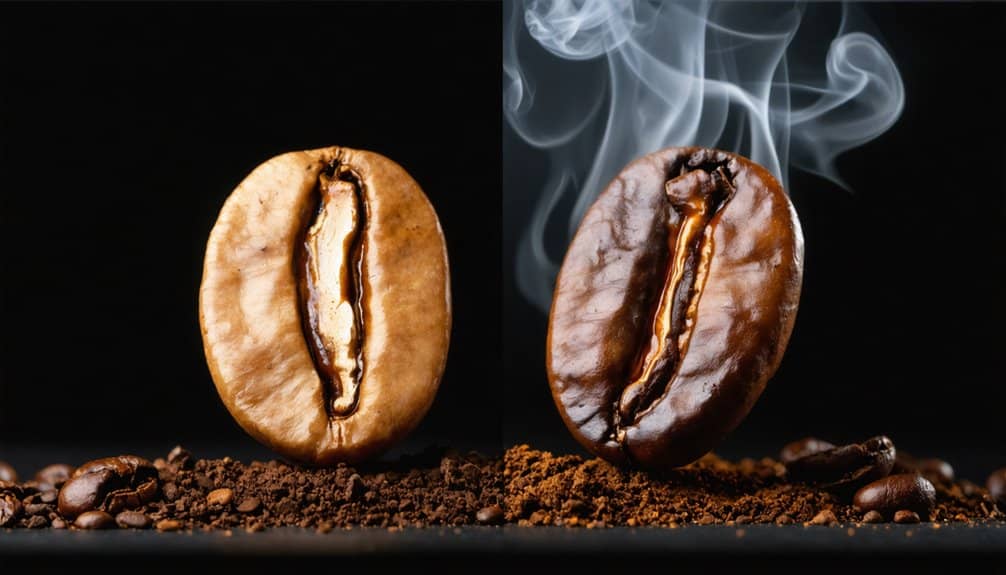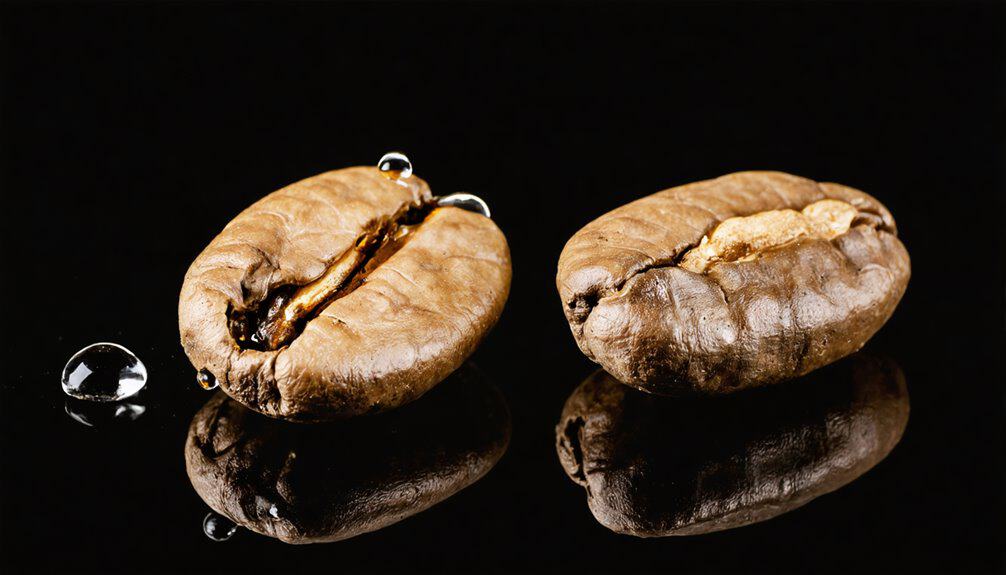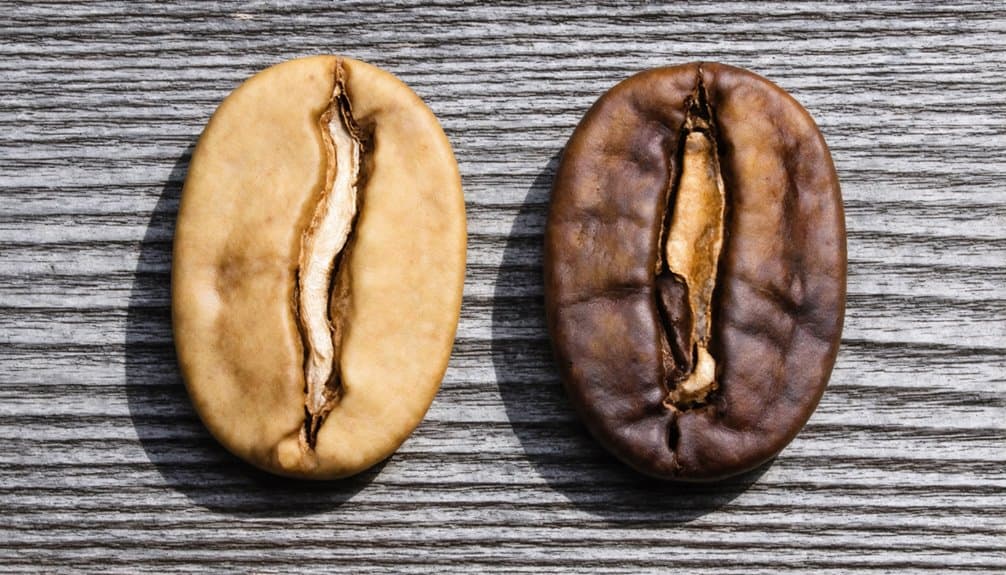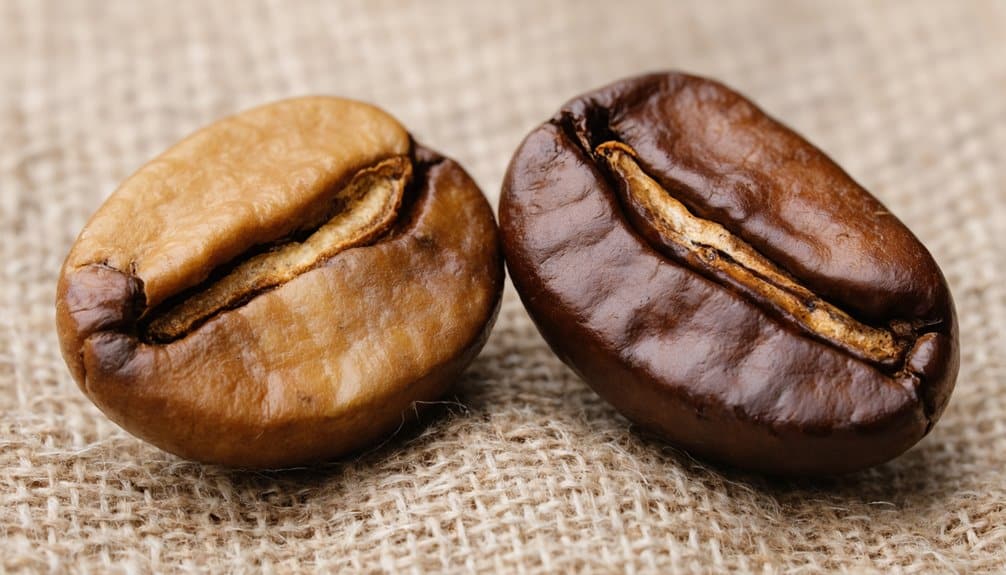When you’re comparing Arabica and Robusta coffee beans, you’ll notice distinct differences in taste, caffeine, and price.
Arabica offers sweeter, more complex flavors with fruity and chocolatey notes, containing 1.2-1.5% caffeine and higher sugar content (6-9%).
It’s grown at higher altitudes and commands premium prices.
Robusta delivers bolder, earthier flavors with nearly double the caffeine (2.2-2.7%) but less sugar (3-7%).
It’s more resistant to pests and cheaper to produce.
While both varieties excel in different brewing methods, understanding their unique characteristics will help you select the perfect bean for your coffee experience.
Key Takeaways
- Arabica offers sweeter, complex flavors with fruity and chocolatey notes, while Robusta delivers bold, earthy tastes with higher caffeine content.
- Arabica beans grow at higher altitudes requiring careful cultivation, making them more expensive than the hardier, lower-altitude Robusta variety.
- Robusta contains nearly double the caffeine of Arabica, providing 184-265mg per cup compared to Arabica’s 100mg per cup.
- Arabica beans are larger and darker with curved creases, while Robusta beans are smaller, rounder, and paler.
- Arabica excels in drip brewing methods showcasing delicate flavors, whereas Robusta performs better in espresso preparations producing thicker crema.
Taste Profile Battles

Coffee’s long-standing battle between Arabica and Robusta begins with their distinct taste profiles, which fundamentally shape your coffee experience.
When you sip Arabica, you’ll detect a sweeter, more nuanced profile with fruity, chocolatey, and floral notes, complemented by a bright acidity that improves its complexity.
The higher sugar and lipid content creates that smooth, pleasant mouthfeel you’re seeking.
This exceptional flavor complexity stems from Ethiopia’s highland origins.
In contrast, when you investigate Robusta, you’ll encounter a bolder, more intense experience dominated by earthy, nutty, and woody flavors.
Its higher caffeine content contributes to a more bitter profile, while its lower acidity results in a fuller body.
Though lacking Arabica’s delicate complexity, Robusta delivers that robust punch many coffee enthusiasts specifically seek in their blends.
Understanding Caffeine Differences
Beyond their distinctive flavor profiles, the caffeine content between Arabica and Robusta creates another significant dimension of difference.
You’ll find Robusta packs nearly double the caffeine punch, containing 2.2-2.7% compared to Arabica’s modest 1.2-1.5%.
This translates to about 100mg per cup with Arabica, while Robusta delivers a potent 184-265mg.
High-quality specialty blends are typically made with Arabica beans, while Robusta is more commonly used in instant coffee products.
If you’re caffeine-sensitive, you’ll want to stick with Arabica’s gentler approach. However, if you’re seeking that extra kick in your espresso or instant coffee, Robusta’s higher caffeine content makes it your ideal choice.
Remember, though, that staying under 400mg daily is vital for your well-being, as exceeding this can trigger insomnia and increased heart rate.
Robusta’s boosted caffeine levels also serve a natural purpose, acting as the bean’s built-in pest defense system.
Sugar and Fat Content

When you taste Arabica and Robusta side by side, you’ll notice Arabica’s naturally higher sugar content (6-9%) creates a distinctly sweeter profile compared to Robusta’s modest 3-7% sugar levels.
The fat content difference is similarly significant, with Arabica containing 15-17% lipids versus Robusta’s 10-12%, which you’ll experience as a richer mouthfeel and more persistent flavors.
While both varieties offer antioxidants and beneficial compounds, Arabica’s higher concentration of natural sugars and fats contributes to a more complex flavor profile that many coffee enthusiasts prefer.
These valuable compounds are best preserved when Arabica is grown in high elevation conditions between 1,500 to 6,000 feet.
Natural Sweetness Differences
The natural sweetness profile between Arabica and Robusta beans reveals a striking contrast in their sugar compositions.
When you’re tasting these two varieties, you’ll notice that Arabica contains nearly double the sugar concentration of Robusta, which greatly impacts your coffee experience.
Arabica’s excellence in producing complex flavor notes is particularly evident in lighter roasts that preserve its delicate characteristics.
| Characteristic | Arabica vs. Robusta |
|---|---|
| Sugar Content | Double vs. Low |
| Taste Profile | Sweet & Complex vs. Bitter & Harsh |
| Mouthfeel | Creamy vs. Woody |
| Flavor Balance | Nuanced vs. Earthy |
This sugar difference directly influences what you’ll taste in your cup. Arabica’s higher sugar content creates a balanced, complex flavor profile with a creamy sensation.
In contrast, Robusta’s low sugar levels contribute to its characteristic bitter, earthier notes that you’ll immediately recognize.
You’ll find this sweetness variance particularly noticeable when comparing single-origin coffees of each variety.
Fat Levels and Taste
Two key components shape the distinct taste profiles of Arabica and Robusta coffee: their fat and sugar content.
With 60% more lipids (15-17%) and nearly double the sugar content (6-9%), Arabica delivers a markedly richer, more complex flavor experience than Robusta.
You’ll find these differences most apparent in both the immediate taste and lingering aftertaste of your brew.
- Arabica’s higher fat content creates a smoother mouthfeel and longer-lasting flavor notes
- The increased sugar levels in Arabica lead to better caramelization during roasting
- Robusta’s lower fat (10-12%) and sugar (3-7%) levels contribute to its characteristic earthiness
When you’re tasting these coffees, you’ll notice how these compositional differences translate into Arabica’s wine-like acidity and sweet complexity, while Robusta presents more straightforward, oatmeal-like notes with a distinct peanut finish.
These taste variations help explain why Arabica accounts for 60% of global coffee production.
Health Benefits Comparison
Understanding the health implications of coffee varieties begins with their fundamental chemical compositions.
When you’re looking at sugar content, you’ll find Arabica contains nearly double the concentration compared to Robusta, enhancing its natural sweetness while supporting beneficial gut bacteria.
The fat content tells a similar story, with Arabica containing 60% more lipids, contributing to better antioxidant absorption and smoother taste.
The slow maturation process of Arabica beans results in their more nuanced and balanced flavor profile.
| Component | Arabica | Robusta |
|---|---|---|
| Sugar Content | 2x higher | 60% less |
| Fat Content | 60% more lipids | Lower lipids |
| Sugar Impact | Supports gut health | Requires additives |
| Fat Benefits | Better antioxidant absorption | Limited absorption |
You’ll notice these differences directly affect both taste and health benefits, with Arabica’s higher concentrations supporting better metabolic health and reducing the need for supplementary sweeteners.
Price and Market Value
You’ll find striking differences in production costs between Arabica and Robusta, with Arabica requiring more intensive care, higher altitudes, and specialized growing conditions that drive up its expenses.
The market traditionally values Arabica at premium prices, though recent data shows an unprecedented convergence, with Robusta prices surging to within $400 per ton of Arabica in August 2024, compared to the historical gap where Arabica commanded more than double Robusta’s price.
Quality improvement efforts in Robusta processing and harvesting have contributed to its rising market value.
The dramatic shift stems from supply chain disruptions in the Red Sea, severe weather impacts on Asian crops, and increasing demand for Robusta in coffee blends, forcing you to reconsider traditional price assumptions in the coffee market.
Production Cost Differences
Production costs stand at the heart of the dramatic price difference between Arabica and Robusta coffee beans.
You’ll find that Arabica’s higher costs stem from its demanding cultivation requirements, including specific elevation needs and meticulous hand-picking processes.
Meanwhile, Robusta’s hardy nature and machine-friendly harvesting make it considerably cheaper to produce.
When you’re exploring these cost differences, you’ll notice three key factors:
- Arabica requires high-altitude growing conditions (2,000-6,000 feet) and precise climate control, driving up production expenses
- Labor costs for Arabica cultivation are higher due to manual harvesting requirements and intensive care needs
- Robusta’s natural resistance to pests and diseases, coupled with its higher yield, results in markedly lower production investments
These fundamental cost variations directly influence the market prices you’ll encounter when purchasing either variety.
The cost gap is further widened by Arabica’s position as a premium-grade coffee that commands higher prices in specialty markets.
Market Price Variations
While production costs historically drove a significant price gap between these varieties, recent market dynamics have dramatically shifted the landscape.
You’ll notice that Robusta prices have surged to nearly match Arabica, with only a $400 per ton difference as of August 2024, compared to the much wider gaps in previous years.
You’re witnessing unprecedented market conditions where Robusta’s value has skyrocketed by 84.39% in just one year.
The latest pricing data shows Robusta reaching 4.985 USD per kilogram in November 2024.
This convergence stems from multiple factors you’ll recognize: severe weather impacts in Vietnam, Uganda, and Ivory Coast, shipping disruptions in the Red Sea, and growing demand for coffee blends.
When you’re tracking coffee prices now, you’ll need to take into account these new market dynamics, as the traditional price hierarchy between these varieties continues to evolve rapidly.
Premium Bean Economics
Every high-quality Arabica bean commands a premium market value, driven by its complex flavor profile and higher production requirements.
You’ll find Arabica averaging 162.92 US cents per pound, while Robusta trades at 108.02 US cents per pound.
Recent market dynamics have narrowed this price gap, with Robusta prices rising due to supply disruptions and increased demand for coffee blends.
Specialty coffee enthusiasts and buyers demonstrate a growing willingness to pay premium pricing for Arabica.
- Production costs remain higher for Arabica due to specific altitude requirements and more demanding growing conditions
- Robusta’s rising quality standards and supply constraints have pushed its market value closer to Arabica
- Market trends indicate continued premium pricing for Arabica, supported by its superior chemical composition and refined taste profile
Despite the converging prices, Arabica’s unique characteristics and production challenges continue to justify its position as the premium coffee bean choice.
Physical Bean Characteristics

Understanding the physical differences between Arabica and Robusta beans starts with their distinctive visual characteristics.
You’ll notice that Arabica beans are larger, more oval-shaped, and darker in color, with a pronounced center crease.
In contrast, Robusta beans are smaller, rounder, and paler, featuring a straighter crease. Bean density varies notably between species, with Robusta beans being much heavier and more compact.
When you’re examining the berries, you’ll find that Arabica produces larger, oval-shaped cherries that ripen slowly and require careful hand-picking.
Robusta berries are more circular and mature faster, making them suitable for mechanized harvesting.
The beans’ internal structure also differs considerably – Arabica beans contain higher concentrations of lipids and sugars, contributing to their superior flavor profile, while Robusta beans pack more caffeine and chlorogenic acid.
Environmental Growing Requirements
Growing Arabica and Robusta coffee requires distinct environmental conditions that significantly impact their cultivation success.
You’ll find Arabica thriving in cooler temperatures between 60-70°F at high altitudes of 800-2,000 meters, while Robusta prefers warmer climates of 70-80°F and can flourish at sea level.
Both varieties demand specific rainfall patterns, with Robusta tolerating wetter conditions than its counterpart.
Most coffee plants thrive with annual rainfall amounts between 1,500-2,500mm.
- Arabica needs slightly acidic soil (pH 5.5-6.0) and performs best under shade trees
- Robusta adapts to more varied pH levels (5.0-6.5) and can handle full sun exposure
- Both benefit from agroforestry systems that improve biodiversity and soil health
Through sustainable practices like organic farming and proper soil management, you’ll optimize your coffee plants’ potential while supporting ecosystem health and adapting to climate change challenges.
Brewing Method Applications

While environmental conditions shape coffee cultivation, the brewing method determines how each variety’s unique characteristics shine through in your cup.
You’ll find Arabica excels in drip and pour-over methods, where its delicate flavors emerge through controlled water flow.
For a richer experience, try French press brewing to amplify Arabica’s natural sweetness.
Clean, odorless water is essential since high mineral content can alter the intended taste profile.
Robusta demands different approaches to tame its bold profile.
You’ll want to use pre-wetting techniques during pour-over brewing and opt for finer grinds to balance its intense flavors. When brewing espresso, Robusta’s higher caffeine content creates a thicker crema, making it a valuable component in espresso blends.
For both varieties, maintain precise temperature control (195-205°F for Arabica, 194-203°F for Robusta) and use clean, filtered water to guarantee optimal extraction.
FAQs
Can Mixing Arabica and Robusta Beans Affect the Shelf Life of Coffee?
You won’t notice any shelf life differences when mixing Arabica and Robusta beans. What matters most is how you’re storing them – keep them in an airtight container away from heat and light.
Which Bean Type Produces More Crema in Espresso Shots?
Think you’re team Arabica all the way? Surprise! Robusta actually produces more crema in your espresso shots, creating a thicker, velvety layer with larger bubbles compared to Arabica’s compact layer.
Do Arabica and Robusta Beans Require Different Roasting Temperatures?
You’ll find that Robusta beans roast best at lower temperatures (around 190°C) while Arabica needs higher heat (205-230°C), reflecting their distinct physical properties and moisture content differences.
How Does Altitude Affect the Flavor Development of Each Bean Type?
You’ll find that high altitudes create slower-maturing Arabica beans with complex, acidic flavors, while lower altitudes suit Robusta’s faster development, producing stronger, less nuanced taste profiles with higher caffeine content.
Are There Significant Differences in Antioxidant Levels Between the Varieties?
With 7-10% chlorogenic acids versus Arabica’s 5.5-8%, you’ll find Robusta packs considerably higher antioxidant levels. You’ll notice greater free radical protection and improved anti-inflammatory benefits in your Robusta brew.
The Bottom Line
Like two heavyweight fighters in distinct weight classes, Arabica and Robusta each command their own territory in the coffee world.
You’ll find Arabica’s delicate complexity shining in specialty brewing, while Robusta’s bold punch boosts espresso blends.
Whether you’re seeking subtle fruit notes or intense caffeine kick, understanding these beans’ distinct profiles lets you craft the perfect cup for your precise brewing needs.
